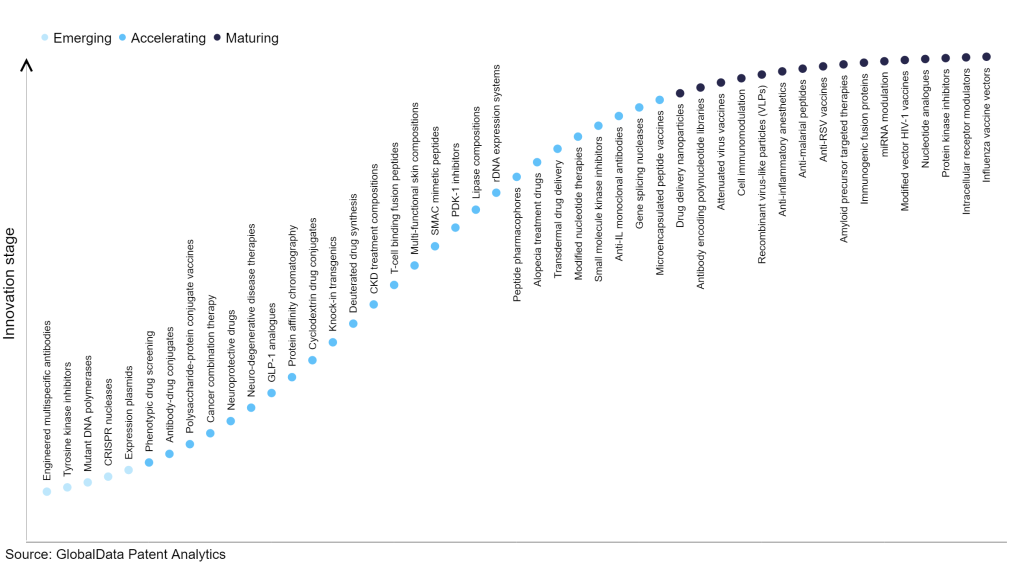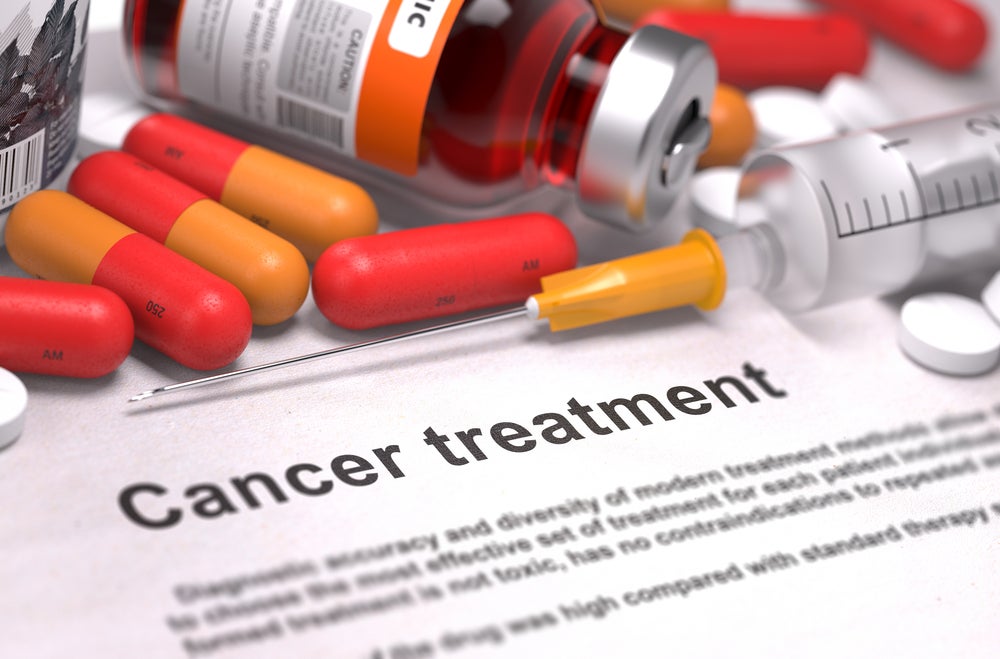The pharmaceutical industry continues to be a hotbed of patent innovation. Activity is driven by the evolution of treatment paradigms, and the gravity of unmet needs, as well as the growing importance of technologies such as pharmacogenomics, digital therapeutics, and artificial intelligence. In the last three years alone, there have been over 787,000 patents filed and granted in the pharmaceutical industry, according to GlobalData’s report on Innovation in pharma: nucleotide analogues. Buy the report here.
However, not all innovations are equal and nor do they follow a constant upward trend. Instead, their evolution takes the form of an S-shaped curve that reflects their typical lifecycle from early emergence to accelerating adoption, before finally stabilizing and reaching maturity.
Identifying where a particular innovation is on this journey, especially those that are in the emerging and accelerating stages, is essential for understanding their current level of adoption and the likely future trajectory and impact they will have.
80+ innovations will shape the pharmaceutical industry
See Also:
According to GlobalData’s Technology Foresights, which plots the S-curve for the pharmaceutical industry using innovation intensity models built on over 668,000 patents, there are 80+ innovation areas that will shape the future of the industry.
Within the emerging innovation stage, engineered multi-specific antibodies, tyrosine kinase inhibitors, and mutant DNA polymerases are disruptive technologies that are in the early stages of application and should be tracked closely. Phenotypic drug screening, antibody-drug conjugates, and polysaccharide-protein conjugate vaccines are some of the accelerating innovation areas, where adoption has been steadily increasing. Among maturing innovation areas are drug delivery nanoparticles and antibody encoding polynucleotide libraries, which are now well established in the industry.
Innovation S-curve for the pharmaceutical industry

Nucleotide analogues is a key innovation area in the pharmaceutical industry
Nucleotide analogues are chemical compounds that mimic the structure of naturally occurring nucleotides, which are the building blocks of DNA and RNA. These analogues can be used for various purposes in molecular biology, genetics, and medicine. They are often employed for their ability to interfere with DNA and RNA synthesis, replication, and repair processes. There are several mechanisms by which nucleoside analogues inhibit viral replication, including competitive inhibition of the viral polymerase and DNA chain termination. There are many antiviral nucleoside analogues that block the 3' hydroxyl group of the deoxyribonucleic acid, which results in a failure to elongate the nascent DNA molecule. Antiviral nucleoside analogues such as negative enantiomers of natural nucleosides interfere with replication partly due to steric hindrance when they are taken up by the viral polymerase or added to DNA strands. Analogues of nucleosides that are phosphorylated at the 5' site are often called nucleotide analogues.
GlobalData’s analysis also uncovers the companies at the forefront of each innovation area and assesses the potential reach and impact of their patenting activity across different applications and geographies. According to GlobalData, there are 170+ companies, spanning technology vendors, established pharmaceutical companies, and up-and-coming start-ups engaged in the development and application of nucleotide analogues.
Key players in nucleotide analogues – a disruptive innovation in the pharmaceutical industry
‘Application diversity’ measures the number of applications identified for each patent. It broadly splits companies into either ‘niche’ or ‘diversified’ innovators.
‘Geographic reach’ refers to the number of countries each patent is registered in. It reflects the breadth of geographic application intended, ranging from ‘global’ to ‘local’.
Patent volumes related to nucleotide analogues
| Company | Total patents (2010 - 2022) | Premium intelligence on the world's largest companies |
| Gilead Sciences | 565 | Unlock Company Profile |
| Johnson & Johnson | 464 | Unlock Company Profile |
| Merck | 315 | Unlock Company Profile |
| Illumina | 305 | Unlock Company Profile |
| F. Hoffmann-La Roche | 285 | Unlock Company Profile |
| Riboscience | 134 | Unlock Company Profile |
| Centre National de la Recherche Scientifique | 132 | Unlock Company Profile |
| SomaLogic | 126 | Unlock Company Profile |
| Ionis Pharmaceuticals | 122 | Unlock Company Profile |
| NuCana | 96 | Unlock Company Profile |
| Agilent Technologies | 94 | Unlock Company Profile |
| Wave Life Sciences | 72 | Unlock Company Profile |
| AstraZeneca | 70 | Unlock Company Profile |
| Medivir | 68 | Unlock Company Profile |
| Pacific Biosciences of California | 57 | Unlock Company Profile |
| Otsuka | 57 | Unlock Company Profile |
| Geron | 54 | Unlock Company Profile |
| BASF | 52 | Unlock Company Profile |
| Changzhou Fangyuan Pharmaceutical | 50 | Unlock Company Profile |
| Thermo Fisher Scientific | 49 | Unlock Company Profile |
| Mitsubishi Chemical Group | 47 | Unlock Company Profile |
| Bonac | 41 | Unlock Company Profile |
| Inner Mongolia Puyin Pharmaceutical | 36 | Unlock Company Profile |
| DNA Script | 36 | Unlock Company Profile |
| ChemGenes | 34 | Unlock Company Profile |
| Qiagen | 34 | Unlock Company Profile |
| Muscle Pharm | 34 | Unlock Company Profile |
| Ligand Pharmaceuticals | 33 | Unlock Company Profile |
| Calithera Biosciences | 33 | Unlock Company Profile |
| Alnylam Pharmaceuticals | 32 | Unlock Company Profile |
| Eisai | 32 | Unlock Company Profile |
| LGC | 31 | Unlock Company Profile |
| Pfizer | 30 | Unlock Company Profile |
| Idenix (Cayman) | 30 | Unlock Company Profile |
| Abbott Laboratories | 29 | Unlock Company Profile |
| Sichuan Kelun Industrial Group | 26 | Unlock Company Profile |
| Nuclera Nucleics | 26 | Unlock Company Profile |
| Arrowhead Pharmaceuticals | 26 | Unlock Company Profile |
| Ipsen | 21 | Unlock Company Profile |
| Cellix Bio | 21 | Unlock Company Profile |
| Novartis | 21 | Unlock Company Profile |
| Suzhou Ribo Life Sciences | 19 | Unlock Company Profile |
| MBC Pharma | 19 | Unlock Company Profile |
| Moderna | 18 | Unlock Company Profile |
| Avalo Therapeutics | 18 | Unlock Company Profile |
| NEW HOPE, CITY OF | 18 | Unlock Company Profile |
| BrightGene Bio-Medical Technology | 17 | Unlock Company Profile |
| Delta-Fly Pharma | 17 | Unlock Company Profile |
| Amgen | 16 | Unlock Company Profile |
| LCB Pharma | 16 | Unlock Company Profile |
Source: GlobalData Patent Analytics
Gilead Sciences is one of the leading patent filers in nucleotide analogues. Nucleotide analogues have been a significant focus for Gilead Sciences, particularly in the treatment of viral infections. Tenofovir disoproxil fumarate, marketed under various brand names (such as Viread), is a nucleotide analogue reverse transcriptase inhibitor (NRTI) used in the treatment of HIV and chronic hepatitis B. Remdesivir is a nucleotide analogue that garnered significant attention during the COVID-19 pandemic. Remdesivir received emergency use authorization (EUA) for the treatment of COVID-19 in some regions and was granted full approval in others. Gilead Sciences markets remdesivir under the brand name Veklury for the treatment of COVID-19 in certain circumstances.
Johnson & Johnson and Merck are some of the other key patent filers in nucleotide analogues.
In terms of application diversity, City of New Hope leads the pack, while AstraZeneca and Calithera Biosciences stood in second and third positions, respectively. By means of geographic reach, SomaLogic held the top position, followed by AstraZeneca and Eisai.
To further understand the key themes and technologies disrupting the pharmaceutical industry, access GlobalData’s latest thematic research report on Pharmaceutical.
Premium Insights
From

The gold standard of business intelligence.
Blending expert knowledge with cutting-edge technology, GlobalData’s unrivalled proprietary data will enable you to decode what’s happening in your market. You can make better informed decisions and gain a future-proof advantage over your competitors.






